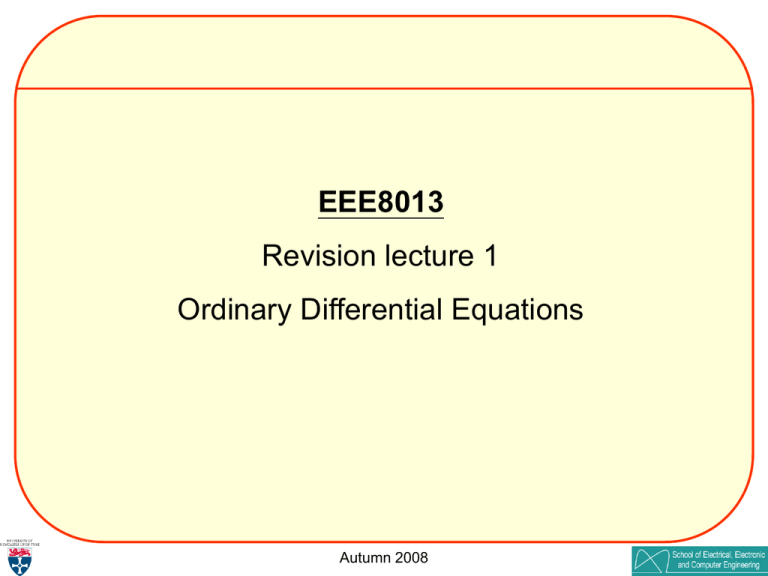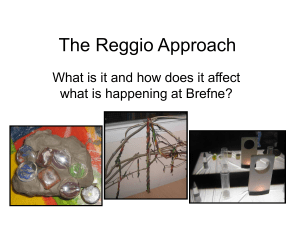Document
advertisement

EEE8013 Revision lecture 1 Ordinary Differential Equations Autumn 2008 Modeling Model: f(t) Ordinary Differential Equations (ODE): x(t) F ma f f friction ma friction dx d 2x f Bu ma f B m 2 dt dt Dynamics: Properties of the system, we have to solve/study the ODE. Autumn 2008 First order systems: Study approaches First order ODEs: dx f ( x, t ) dt Analytic: Explicit formula for x(t) (a solution – separate variables, integrating factor) which satisfies dx f ( x, t ) dt dx a dx adt xt at C INFINITE curves (for all Initial Conditions (ICs)). dt Autumn 2008 First order linear equations First order linear equations - (linear in x and x’) a(t ) x'b(t ) x c(t ), Non autonomous Autonomous ax'bx c, General form: x'kx u 0.1 Numerical Solution: k=5, u=0.5 0.08 0.06 k Gain u u u Dx 1 s 0.04 x x Integrator Scope 0.02 0 0 Autumn 2008 1 2 3 4 Analytic solution: Step input kdt e k const e kt ekt x'kx ektu ekt x ' ektu e kt x ' dt e kt udt e kt x e kt udt c x e kt e kt udt e kt c xe kt x0 e kt t kt1 e udt1 0 Autumn 2008 Response to a sinusoidal input y1 ' ky1 k cos t y2 ' ky2 k sin t jy2 ' kjy2 kj sin t jy2 ' kjy2 y1 ' ky1 kj sin t k cos t y1 ' jy2 ' k y1 jy2 k cos t j sin t ~ y ' k~ y ke jt e kt ~ y ~yekt ' kek jt 1 k j t tan e 1 1 2 k2 ~ y ekt k k y e jt ek jt ~ k jt k jt 1 1 j t tan ~ k Re y Re e 2 1 2 k 1 Autumn 2008 k cos t tan1 1 2 k2 Response to a sinusoidal input k Gain 1 s Sine Wave Clock Integrator Gain2 Math Function -k Gain1 Scope 1 s eu k total total Product steady state Integrator1 Product1 Scope1 eu Math Function1 Scope3 0.25 0.1 Gain3 0.2 Transient Steady state Overall Transient Scope2 0.15 0.1 0.05 0 -0.05 -0.1 -0.15 -0.2 0 Autumn 2008 2 4 6 8 10 Second order ODEs d 2x f ( x ' , x, t ) Second order ODEs: dt 2 dx d 2x at C1 x 0.5at2 C1t C2 a 2 dt dt So I am expecting 2 arbitrary constants x' ' Ax' Bx u u=0 => Homogeneous ODE x' ' Ax' Bx 0 x e rt Let’s try a x e rt x ' re rt x' ' r 2 e rt x' ' Ax' Bx 0 r 2 e rt Are rt Be rt 0 r 2 Ar B 0 A A2 4 B r x1 , x2 2 Autumn 2008 x C1x1 C2 x2 Overdamped system A A2 4 B r 2 x1 e r1t A 4B 2 Roots are real and unequal x2 e r2t x C1 x1 C2 x2 C1e r1t C2e r2t x' '4 x'3x 0 x e rt 1.5 Overall solution r 2 4r 3 0 r 3r 1 0 x C1e3t C2e t x' 3C1e3t C2et x0 1 x' 0 0 x' 0 3C1 C 2 0 x 0.5e x2 0.5 x0 C1 C 2 1 3t 1 0 3 e t 2 x1 -0.5 0 1 Autumn 2008 2 3 4 5 6 Critically damped system A A2 4 B r 2 A2 4B Roots are real and equal x1 e rt x2 te rt x C1x1 C2 x2 C1e rt C2te rt 1 e-t 0.9 0.8 te-t 0.7 A=2, B=1, x(0)=1, x’(0)=0 => c1=c2=1 overall 0.6 0.5 0.4 0.3 0.2 0.1 0 0 2 Autumn 2008 4 6 8 10 Underdamped system A A2 4 B r 2 r=a+bj A2 4B A0 Roots are complex x e rt ea bj t e at bjt Underdamped system at e at e jbt e cos(bt) j sin( bt) Theorem: If x is a complex solution to a real ODE then Re(x) and Im(x) are the real solutions of the ODE: x1 e at cos(bt), x2 e at sin( bt) G x c1x1 c2 x2 c1eat cos(bt) c2eat sin( bt) eat c1 cos(bt) c2 sin( bt) eatG cosbt , & tan 1 c2 c1 c cos tan 1 2 c1 c1 Autumn 2008 Underdamped system, example A=1, B=1, x(0)=1, x’(0)=0 => c1=1, c2=1/sqrt(3) eat c1 cos(bt) c2 sin( bt) 1.5 eatG cosbt 1.5 C1cos(bt) 1 C1cos(bt)+C2sin(bt) 0.5 C1cos(bt)+C2sin(bt) 0.5 0 0 -0.5 -0.5 C2sin(bt) -1 -1.5 0 eat 1 -1 2 4 6 8 10 -1.5 0 Autumn 2008 Overall 2 4 6 8 10 Undamped A0 Undamped system x' '0 Bx 0 r 2e rt 0 Be rt 0 r 2 B x c1 cos(bt) c2 sin( bt) G cosbt A=0, B=1, x(0)=1, x’(0)=0 =>c1=1, c2=0: 1 0.8 0.6 0.4 Overall 0.2 0 -0.2 -0.4 -0.6 -0.8 -1 0 2 4 6 Autumn 2008 8 10 Stability In all previous cases if the real part is positive then the solution will diverge to infinity and the ODE (and hence the system) is called unstable. jb jb a a Critical or overdamped Stable underdamped Unstable Autumn 2008 Natural frequency, damping frequency, damping factor A 2n , B n2 x' '2 n x'n2 x 0 is the damping factor and n is the natural frequency of the system. A A2 4 B 2 n r 2 2 n 2 4n2 2 r n 2n2 n2 Case 1: n2 2 n2 0 1 1 2 r1, 2 n 2n2 n2 => Overdamped system implies that x C1er1t C2er2t Autumn 2008 1 Natural frequency, damping frequency, damping factor Case 2: 2n2 n2 2 1 1 r n x C1en t C2te n t Case 3: n2 2 => Critically damped system implies that 1 n2 0 1 1 => Underdamped systems implies 1 2 r1, 2 n j n2 n2 2 x e n t G cosd t n jn 1 d 2 d n 1 2 n jd called damped frequency or pseudo-frequency Case 4: 0 r j n x G cosn t No damping the frequency of the oscillations = natural frequency Autumn 2008 Summary Autumn 2008 Stability revised If 0 then cases 1-3 are the same but with k 0 jd n j d n Critical or overdamped Stable underdamped Unstable Autumn 2008 NonHomogeneous (NH) differential equations x' ' Ax' Bx u u=0 => Homogeneous => x1 & x2. Assume a particular solution of the nonhomogeneous ODE: xp If u(t)=R=cosnt => x P R B Then all the solutions of the NHODE are x x P c1 x1 c2 x2 So we have all the previous cases for under/over/un/critically damped systems plus a constant R/B. If complementary solution is stable then the particular solution is called steady state. Autumn 2008 Example x 2 c1x1 c2 x2 2 eat c1 cos(bt) c2 sin( bt) x' ' x' x 2 x P 2 x(0)=1, x’(0)=0 => c1=-1, c2=-1/sqrt(3) 2.5 2 1.5 Particular solution Overall 1 Homogeneous solution 0.5 0 -0.5 -1 0 2 4 Autumn 2008 6 8 10 State Space x n f x, x' , x' ' ,...x n 1 Very difficult to be studied => so we use computers Computers are better with 1st order ODE 1 nth => n m x F B x kx x1 x x2 x1 x x2 x 1st Powerful tools from the linear algebra x2 x 1 F Bx2 kx1 m 0 x1 k x 2 m 0 x1 k x 2 m 1 x 0 B 1 x2 F m m 1 x 0 1 B F X AX BU x2 1 m m Autumn 2008 Use sensors: Output = x => x1 y x 1 0 y CX DU x2 State Space X AX BU y CX DU Input U U1 U1 Uq U X AX BU y CX DU X AX BU y CX DU X AX BU y CX DU Output y y1 y2 yp Y u1 y1 u y 2 2 U , Y y3 u q yp Autumn 2008 X(t ) At X(t ) B(t )U(t ) Y(t ) C(t ) X(t ) D(t )U(t ) Block Diagram X(t ) At X(t ) B(t )U(t ) Y(t ) C(t ) X(t ) D(t )U(t ) •X is an n x 1 state vector •U is an q x 1 input vector •Y is an p x 1 output vector •A is an n x n state matrix •B is an n x q input matrix •C is an p x n output matrix •D is an p x m feed forward matrix (usually zero) X(t ) AX(t ) BU(t ) Y(t ) CX(t ) DU(t ) U B DX dt A Autumn 2008 X C Y State space rules The state vector describes the system => Gives its state => The state of a system is a complete summary of the system at a particular point in time. If the current state of the system and the future input signals are known then it is possible to define the future states and outputs of the system. The choice of the state space variables is free as long as some rules are followed: 1. They must be linearly independent. 2. They must specify completely the dynamic behaviour of the system. 3. Finally they must not be input of the system. Autumn 2008 State space The system’s states can be written in a vector form as: x1 x1 , 0, , 0T x2 0, x2 , , 0T ... x n 0, 0, , xn T 2 R x3 x2 A standard orthogonal basis (since they are linear independent) for an n-dimensional vector space called state space. R x2 x 1 x1 3 Matlab definition Autumn 2008 Solution x1 2 2 x1 2 5 x2 x 2 x1 2 x1 2 x2 x2 2 x1 5 x2 1 x2 5 x2 2 1 x1 x2 5 x2 2 1 x2 5 x2 2 1 x2 5 x2 2 x2 2 2 1 5 x2 x 2 x2 5 x2 2 x2 2 2 x2 5 x2 2 x2 10x2 4 x2 x2 7 x 2 6 x2 0 x1 Autumn 2008 x2 7 x2 6 x2 0 r 2 7r 6 0 xa Cet xb De 6t Solution II x1 2 2 x1 2 5 x2 x 2 a1 t X e a2 a1 t X e a2 a1 a1 2a1 2a2 2 2 a1 t X e t e a 2a 5a a a 2 5 2 2 2 1 2 How can we solve that ??? Assume is a parameter => A homogeneous linear system 2 a1 2a2 0 2a1 5 a2 0 2 2 2 5 0 2 7 6 0 (This last equation is the characteristic equation of the system, why???). Autumn 2008 Solution III 1 2 7 6 0 1 2 6 1 1 a1 2a2 0 2a1 4a2 0 I assume that a2=1 so a1=2 1 6 4a1 2a2 0 2 a a 0 1 2 a 2 1: 1 a2 1 2 X1 (t ) e t 1 I assume that a1=2 so a2=-2 2 1 Xt C1 e t C 2 e 6t 1 2 Matlab example Autumn 2008 1 X 2 (t ) e 6t 6 General Solution X AX X c e et e A e I Ae 0 I A 0 The roots of this equation are called eigenvalues e i i 1 2 2 ...n Xt C1e1e1t C2e2e2t ... Cnenent negative eigenvalues => stable positive eigenvalues => unstable repeated eigenvalues => eigenvectors are not linearly independent. Complex eigenvalues => conjugate and the eigenvector will be complex =>solution will consists of sines, cosines and exponential terms Autumn 2008 Properties of general solution Xt C1e1e1t C2e2e2t ... Cnenent If we start exactly on one eigenvector then the solution will remain on that forever. Hence if I have some stable and some unstable eigenvalues it is still possible (in theory) for the solution to converge to zero if we start exactly on a stable eigenvector. Ci ei eit e it ei Ci Determines the nature of the time response (stable, fast..) Determines the extend in which each state contributes to e Determines the extend in which the IC excites the e it To find the eigenvalues and eigenvectors use the command eig() Autumn 2008 i t Example state space x1 2 2 x1 2 5 x2 x 2 1.5 1 e1 x2 0.5 0 0,0 -0.5 -1 -1 e2 -0.5 0 0.5 x1 Autumn 2008 1 1.5 Example Autumn 2008 Example Autumn 2008 State Transition Matrix Until now the use of vector ODEs was not very helpful. We still have special cases x ax e At xt e at x0 I A 0 X AX X e At X0 => No special cases are needed then e At At 1 At 2 1 At 3 ... 2! 3! x1 2 2 x1 2 5 x2 x 2 4 ways to calculate it!!! Use the command expm (not exp)! 2 2 A 2 5 X(0)=[1 2] X(5) =? Autumn 2008 State Transition Matrix Xt C1 e1e1t C2 e 2 e 2t ... Cn e n e nt X e At X0 1 e n n Ae1 e 2 e n e1 e 2 Aei e i λi A TΛ1 AT TΛ e At At 2 3 1 At 2 1 At 3 ... TΛ1 t 1 TΛ1 t 1 TΛ1 t ... 2! 3! 2! 3! TΛ1 2 TΛ1 TΛ1 TΛ21 e At 1 1 TI TΛ t TΛ 21 t 2 TΛ31 t 3 ... 2! 3! 1 1 T Λt Λt 2 Λt 3 ...1 Te Λt 1 2! 3! 1 1 Autumn 2008 e Λt e 1t n t e State Transition Matrix X e At X0 Te Λt 1X0 X e1 e 2 X e1 e 2 e 1t e n e 1t e n 1 e1 e 2 e n X0 e nt w 1 w 2 X0 e nt w n n Xt e1e w1x10 e2e w 2 x2 0 ... ei e 1t 2t i 1 X e1 e 2 i t w i xi 0 w x (0) e1t 1 1 w 2 x2 (0) en t e n w n xn (0) n Xt ei eit bi 0 i 1 Xt C1 e1e1t C2 e 2 e 2t ... Cn e n e nt Autumn 2008 Solution x ax bu x ax bu t e at d at e at x ax e xt dt t t d a a at a dt e x d e bud e xt x0 e bud 0 0 0 xt e x0 e at t at e a t bud xt e x0 e a t bud at 0 0 t Xt e At X0 e At BUd 0 Autumn 2008 e at bu SS => TF??? LT X(t ) AX(t ) BU(t ) sX(s) X(0) AX(s) BU(s) sI AX(s) BU(s) X(0) X(s) sI A1BU(s) sI A1 X(0) Y(s) CX(s) DU(s) Y(s) C sI A1 BU(s) sI A1 X(0) DU(s) Y(s) CsI A1 B D U(s) CsI A1 X(0) CsI A 1 B D TF CsI A1 X(0) Response to ICs Autumn 2008 SS => TF??? ILT X( s) sI A BU( s) sI A X(0) 1 1 X(t ) L sI A X(0) X(t ) L1 sI A1 BU(s) L1 sI A1 X(0) 1 1 X(t ) e X(0) At Gs CsI A1 B D The TF is a matrix e At L1 sI A1 G s G11( s) G12 ( s) G ( s ) G ( s ) 21 22 G ( s) G p1 ( s) G p 2 ( s) sI A D BC sI A G1q ( s) G2 q ( s) G pq ( s) sI A CE of the TF Y1 Y1 Y Y2 G11, G12, 2 G21, G22... U1 U2 U1 U2 Autumn 2008 SS => TF??? Example: Find the TF of x1 0 x 2 1 x1 0 1 0.5 x 1 2 2 Autumn 2008 x1 y 1 0 x2 Basic properties of state space State space transformations State space representations are not unique Same input/output properties, => same eigenvalues X(t ) AX(t ) BU(t ) X TZ Z is the new state vector Y(t ) CX(t ) DU(t ) T is an invertible matrix Z T 1X Z T 1 X Z T1AX(t ) T1BU(t ) ~ ~ Z T ATZ T BU(t ) Z AZ BU(t ) 1 1 ~ ~ A T1AT B T1B ~ ~ Y(t ) CTX DU(t ) Y(t ) C X DU(t ) ~ C CT ~ DD Autumn 2008 Basic properties of state space ~ ~ 1 ~ ~ 1 Do these two systems have the TF? G1s CsI A B D G2 s CsI A B D G1s CsI A1B D T B D~ ~ G1s C TT1 sI A1 TT1 B D G1 s CT TsI A T1 ~ G1 s C sI TAT1 1 1 Matlab example 1B~ D~ ~ ~ 1 ~ ~ G1 s CsI A B D G 2 s Autumn 2008 Observability - Controllability Observability - Controllability x 2 x 2u y 3x 2 0 2 X X 1 u 0 1 y 3 0X Notice the structure of A and C x 2 x 2u 3s 21 2 6 s2 y 3x 2 0 2 1 s 2 0 X X u 2 0 1 1 3 0 1 0 s 1 y 3 0X 3 0 2 s 1 2s 1 2 0 3 0 s2 s 2 1 6 0 3 0 s 2 s 2s 1 s 2s 1 2 s2 s 1 Autumn 2008 Observability - Controllability There is a pole zero cancellation sI A B C D s2 0 0 0 2 0 0 s 1 1 0 s 2 1 s 1 1 0 1 0 s 1 0 2 0 0 0 1 0 1 0 s 1 0 s 1 pzmap(ss_model) Matlab verification x1 2 0 x1 2 x 0 1 x 1 u 2 2 x1 y 3 0 x 2 2 0 2 X X 1 u 0 1 y 3 0X The cancellation is due to C=[3 0]. x 1 2 x1 u x 2 x2 u y 3 x1 We can influence x2 through U but we cannot observe how it behaves and hence there is no way to feedback that signal to a controller!!! Autumn 2008 Observability - Controllability 2 0 2 X X 1 u 0 1 y 3 0X 2 0 2 X X 0 u 0 1 y 3 2X In this case we can see how both states behave but we can not change U in any way so that we can influence x2 due to the form of B. Unobservable & uncontrollable 0 2 s 1 3 2 s 2 0 0 s 1s 2 3 s 2 Minimal realisation. Difficult task if the system is nonlinear!!!! Autumn 2008 2 2 6 s 1 0 s 2 Observability - Controllability C CA 2 M O CA n 1 CA MC B AB A2B An 1B Check the rank >> rank(obsv(A,C)) >> rank(ctrb(A,B)) Autumn 2008







